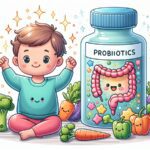Monitoring air quality for baby’s health: Tips for indoor and outdoor settings is a critical component of ensuring a safe and healthy environment for our youngest family members. This guide aims to provide parents and caregivers with comprehensive insights and practical strategies for safeguarding infants from harmful air pollutants, both inside the home and in outdoor spaces.
The Importance of Clean Air for Infants
Infants are particularly susceptible to the effects of poor air quality due to their developing respiratory systems and higher breathing rates compared to adults. Exposure to air pollutants can lead to respiratory infections, asthma, and other health issues in babies. Thus, understanding and improving the air quality around infants is paramount.
Studies have shown that indoor air can be more polluted than outdoor air, making it essential to focus on creating a safe indoor environment. Factors such as household cleaning products, mold, pet dander, and tobacco smoke can significantly deteriorate indoor air quality. (EPA, n.d.) For outdoor settings, traffic emissions, industrial pollution, and pollen contribute to air pollution levels that can impact baby’s health.
Monitoring Air Quality for Baby’s Health: Tips for Indoor and Outdoor
Monitoring air quality for baby’s health involves being proactive and implementing measures to reduce exposure to harmful pollutants. Indoor air quality monitors are invaluable tools for detecting levels of common indoor pollutants such as volatile organic compounds (VOCs), particulate matter (PM2.5), and carbon monoxide (CO).
For outdoor air quality, staying informed about air pollution forecasts and avoiding outdoor activities when pollution levels are high can protect infants. Utilizing air purifiers with HEPA filters inside the home can also improve air quality by removing airborne pollutants. Ensuring good ventilation, using natural cleaning products, and maintaining a smoke-free home are additional strategies that contribute to healthier air for babies. Read more on minimizing exposure to air pollution for babies and toddlers.
Practical Measures for Ensuring Healthy Air at Home
Creating a safe indoor environment starts with regular maintenance of heating, ventilation, and air conditioning (HVAC) systems. Changing filters regularly and using air purifiers can significantly reduce indoor air pollutants. Additionally, keeping indoor humidity levels in check (between 30% and 50%) can prevent mold growth and reduce dust mites.
Incorporating indoor plants that have air-purifying qualities, such as spider plants and peace lilies, can naturally improve air quality. However, it’s essential to keep these plants out of reach of babies and children to avoid any risk of ingestion. Learn more about creating a non-toxic nursery. Additionally, using non-toxic cleaning products is crucial for maintaining a healthy indoor air environment.
Conclusion
Monitoring air quality for baby’s health is an essential aspect of parenting that requires awareness and proactive measures. By understanding the sources of indoor and outdoor air pollution and implementing strategies to mitigate their impact, parents can create a safer environment for their infants. Regular monitoring, using air purifiers, ensuring proper ventilation, and choosing non-toxic household products are effective ways to improve air quality for baby’s health.
Remember, taking steps to ensure clean air is not just about immediate health benefits; it’s also about contributing to the long-term wellbeing of your baby. For more tips and guides on ensuring your baby’s health and safety, visit BabyWhysAndHows.com.













